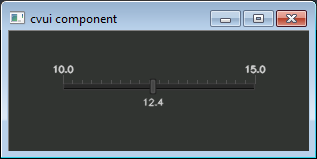Trackbar
cvui::trackbar() renders a trackbar for numeric values that users can increase/decrease by clicking and/or dragging the marker right or left. The signature of the function is:
template <typename T>
bool trackbar (
cv::Mat& theWhere,
int theX,
int theY,
int theWidth,
T *theValue,
T theMin,
T theMax,
int theSegments = 1,
const char *theLabelFormat = "%.1Lf",
unsigned int theOptions = 0,
T theDiscreteStep = 1
)
where theWhere is the image/frame where the image will be rendered, theX is the position X, theY is the position Y, theWidth is the width of the trackbar, theValue is the current value of the trackbar, theMin is the minimum value allowed for the trackbar, theMax is the maximum value allowed for the trackbar.
The parameter theValue will be modified when the user interacts with the trackbar. Any numeric type can be used, e.g. float, double, long double, int, char, uchar.
cvui::trackbar() returns true when the value of the trackbar changed, or false if the value remains the same since the last interaction.
cvui::trackbar() uses C++ templates, so it is imperative that you make it very explicit the type of parameters theValue, theMin, theMax and theStep, otherwise you might end up with weird compilation errors.Below is an example showing a trackbar. The result on the screen is shown in Figure 1.
double value = 12.4;
cvui::trackbar(frame, 40, 30, 220, &value, (double)10.0, (double)15.0);

Figure 1: trackbar component using double values.
Customization
Trackbars can be highly customized. Parameter theSegments indicates the number of segments the trackbar will have (default is 1). Segments can be seen as groups of numbers in the scale of the trackbar. For example, 1 segment means a single groups of values (no extra labels along the scale), 2 segments mean the trackbar values will be divided in two groups and a label will be placed at the middle of the scale.
Parameter theLabelFormat is the formatting string that will be used to render the labels, e.g. %.2Lf (Lf not lf). No matter the type of the theValue param, internally cvui::trackbar() stores it as a long double, so the formatting string will always receive a long double value to format. If you are using a trackbar with integers values, for instance, you can supress decimals using a formating string such as %.0Lf to format your labels.
Parameter theOptions provide options to customize the behavior/appearance of the trackbar, expressed as a bitset. Available options are defined as TRACKBAR_ constants and they can be combined using the bitwise | operand. Available options are:
TRACKBAR_HIDE_SEGMENT_LABELS: do not render segment labels, but do render min/max labels;TRACKBAR_HIDE_STEP_SCALE: do not render the small lines indicating values in the scale;TRACKBAR_DISCRETE: changes of the trackbar value are multiples oftheDiscreteStepparam;TRACKBAR_HIDE_MIN_MAX_LABELS: do not render min/max labels;TRACKBAR_HIDE_VALUE_LABEL: do not render the current value of the trackbar below the moving marker;TRACKBAR_HIDE_LABELS: do not render labels at all.
The parameter theDiscreteStep is the amount that the trackbar marker will increase/decrease when the marker is dragged right/left (if option TRACKBAR_DISCRETE is active). Figures 2 and 3 illustrate the differences.

Figure 2: trackbar component without discrete step.

Figure 3: trackbar component using a discrete step.
Learn more
Check the sparkline example for more information about sparklines.